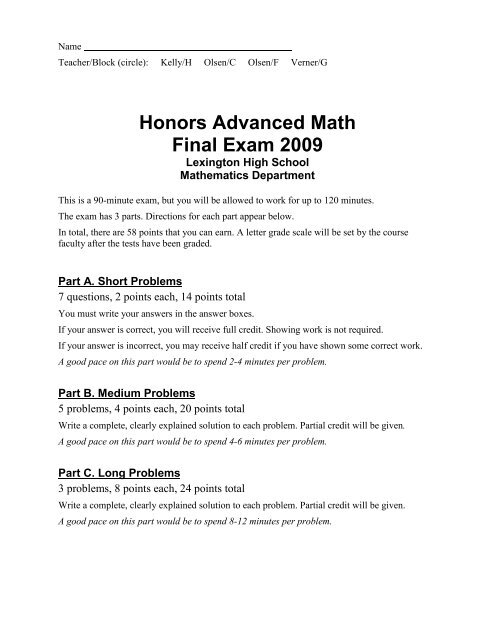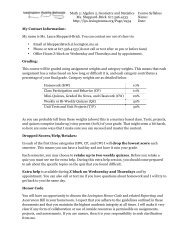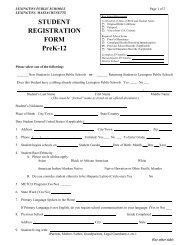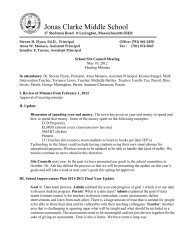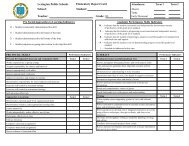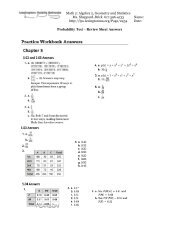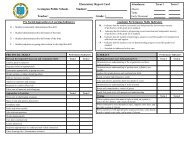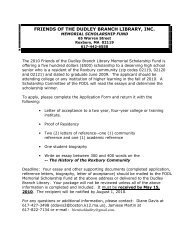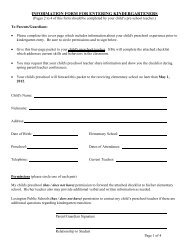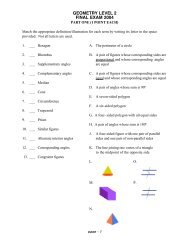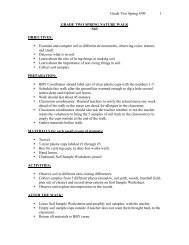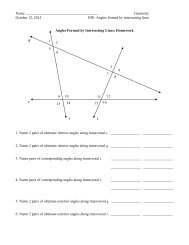questions - Lexington Public Schools
questions - Lexington Public Schools
questions - Lexington Public Schools
Create successful ePaper yourself
Turn your PDF publications into a flip-book with our unique Google optimized e-Paper software.
Name<br />
Teacher/Block (circle): Kelly/H Olsen/C Olsen/F Verner/G<br />
Honors Advanced Math<br />
Final Exam 2009<br />
<strong>Lexington</strong> High School<br />
Mathematics Department<br />
This is a 90-minute exam, but you will be allowed to work for up to 120 minutes.<br />
The exam has 3 parts. Directions for each part appear below.<br />
In total, there are 58 points that you can earn. A letter grade scale will be set by the course<br />
faculty after the tests have been graded.<br />
Part A. Short Problems<br />
7 <strong>questions</strong>, 2 points each, 14 points total<br />
You must write your answers in the answer boxes.<br />
If your answer is correct, you will receive full credit. Showing work is not required.<br />
If your answer is incorrect, you may receive half credit if you have shown some correct work.<br />
A good pace on this part would be to spend 2-4 minutes per problem.<br />
Part B. Medium Problems<br />
5 problems, 4 points each, 20 points total<br />
Write a complete, clearly explained solution to each problem. Partial credit will be given.<br />
A good pace on this part would be to spend 4-6 minutes per problem.<br />
Part C. Long Problems<br />
3 problems, 8 points each, 24 points total<br />
Write a complete, clearly explained solution to each problem. Partial credit will be given.<br />
A good pace on this part would be to spend 8-12 minutes per problem.
Honors Advanced Math 2009 Final Exam — page 2 of 12<br />
Part A. Short Problems<br />
7 problems, 2 points each, 14 points total<br />
1. Algebraically, solve the equation 2cos( 3x −1)= 3. Find all solutions, and give their exact<br />
values, not decimal approximations.<br />
Answer to question 1:<br />
2. Consider the infinite geometric series 4x + 12x 3 + 36x 5 + 108x 7 + ···. Find the interval of<br />
x values for which the sum of this series is finite. For those x values, find the sum of the series.<br />
Answers to question 2:<br />
interval of x values:<br />
sum of the series:
Honors Advanced Math 2009 Final Exam — page 3 of 12<br />
⎛<br />
3. Consider the ellipse given by the equations ⎜<br />
⎝<br />
equations for this ellipse.<br />
x − 6<br />
3<br />
⎞<br />
⎟<br />
⎠<br />
2<br />
⎛<br />
+ y − 8 ⎞<br />
⎜ ⎟<br />
⎝ 4 ⎠<br />
2<br />
=1. Write parametric<br />
Answer to question 3:<br />
x = y =<br />
4. Kryptonite and adamantium are (fictitious) elements that exhibit radioactive decay.<br />
Suppose there are 2500 mg of kryptonite at time t = 0 days, and that kryptonite has a half-life<br />
of 10 days. Also suppose that there are 3000 mg of adamantium at t = 4 days and 750 mg of<br />
adamantium at t = 12 days.<br />
At what time is the amount of kryptonite equal to the amount of adamantium<br />
(You may give your answer as a decimal approximation accurate to the nearest 0.01.)<br />
Answer to question 4:
Honors Advanced Math 2009 Final Exam — page 4 of 12<br />
5. The graph of a sinusoidal function f(x) on the<br />
window [–10, 10] by [–10, 10] is shown. All<br />
maxima and minima have whole-number<br />
coordinates.<br />
Write a formula involving sine for this function.<br />
Answer to question 5:<br />
f(x) =<br />
6. Find the domain and range for the piecewise function f ( x)<br />
2<br />
⎧ x − 2x<br />
− 3<br />
⎪<br />
⎪ x − 3<br />
= ⎨<br />
⎪ x<br />
− 2 − 3<br />
⎪<br />
⎩<br />
if<br />
if<br />
x ≥ 1,<br />
x < 1.<br />
Answers to question 6:<br />
domain:<br />
range:
Honors Advanced Math 2009 Final Exam — page 5 of 12<br />
7. The graph of a rational function r(x) on the<br />
window [–10, 10] by [–10, 10] is shown.<br />
Although not visible, the graph has a one hole, at<br />
the point (–1, 0).<br />
Write a possible function formula for r(x).<br />
Answer to question 7:<br />
r(x) =
Honors Advanced Math 2009 Final Exam — page 6 of 12<br />
Part B. Medium Problems<br />
5 problems, 4 points each, 20 points total<br />
⎛ M ⎞<br />
8. Suppose b, N, and M are positive numbers. Prove log b<br />
M − log b<br />
N = log b ⎜ ⎟ . You may<br />
⎝ N ⎠<br />
assume the properties of exponents and you may assume that logarithmic and exponential<br />
functions are inverses of each other. You may not assume log properties such as<br />
log b<br />
M + log b<br />
N = log b ( MN).<br />
9. a. In the diagram at the right, find an expression for the length x in terms<br />
of trigonometric functions of α and/or β.<br />
b. Suppose α + β = 3<br />
π . Show that x = 1 + 2 sin(α) sin(β).
Honors Advanced Math 2009 Final Exam — page 7 of 12<br />
10. Consider the function ( x)<br />
= sin( 2x<br />
− 6) + ( 2x<br />
− 6) 7<br />
3 +<br />
f .<br />
a. Find a sequence of two basic transformations (translations, dilations, rotations, or<br />
reflections) that transforms the graph of f ( x)<br />
= sin( 2x<br />
− 6) + ( 2x<br />
− 6) 3 + 7 into the graph<br />
of an odd function. Let g(x) stand for the function after the first transformation, and let<br />
h(x) be the final function that should be odd. Identify the two transformations and give<br />
formulas for g(x) and h(x).<br />
first transformation:<br />
function after first transformation: g(x) =<br />
second transformation:<br />
odd function after second transformation: h(x) =<br />
b. Algebraically prove that function h(x) from above is an odd function. Make sure your proof<br />
is clear and well organized.
Honors Advanced Math 2009 Final Exam — page 8 of 12<br />
11. a. Find the complex conjugate of the polar complex number cis ( )<br />
5π<br />
2<br />
4<br />
,<br />
where cis(θ) denotes cos(θ) + i sin(θ). Express your answer in the form a + bi.<br />
b. Suppose p(x) is polynomial function with the following properties:<br />
• p(x) has degree 4.<br />
• p(x) has real coefficients.<br />
• When the real numbers are used as inputs, the range of p(x) is ( ∞,0]<br />
5 π<br />
• p(1) = –39, p(–2) = 0, and ( cis ( )) = 0<br />
p .<br />
2<br />
4<br />
− .<br />
Find a function formula for p(x). You may leave your answer in factored form.
Honors Advanced Math 2009 Final Exam — page 9 of 12<br />
12. In triangle ∆ABC, let a stand for the length of the side opposite angle A, let b stand for the<br />
length of the side opposite angle B, and let c stand for the length of the side opposite angle C.<br />
Prove the Law of Cosines, c 2 = a 2 + b 2 – 2 ab cos C, in the case where angle C is an<br />
acute angle. You may use any formulas from this course or a previous course that are not<br />
dependent on, or equivalent to, the Law of Cosines.<br />
y<br />
B<br />
C<br />
A<br />
x
Honors Advanced Math 2009 Final Exam — page 10 of 12<br />
Part C. Long Problems<br />
3 problems, 8 points each, 24 points total<br />
13. A parabola has its focus at the origin, and its directrix is the line x = 4.<br />
a. Find an x-y equation (i.e., rectangular equation or Cartesian equation) for the parabola.<br />
Sketching the parabola first may help.<br />
b. Find a polar equation for the parabola.<br />
c. Now suppose the parabola is rotated 30º counterclockwise about the origin. Find an x-y<br />
equation for the rotated parabola. Note: Rotation by angle θ counterclockwise about the<br />
⎡x′<br />
⎤ ⎡cosθ<br />
− sinθ<br />
⎤⎡x⎤<br />
origin has the transformation equation ⎢ ⎥ = ⎢<br />
⎥⎢<br />
⎥ . You do not need to<br />
⎣y′<br />
⎦ ⎣sinθ<br />
cosθ<br />
⎦⎣y<br />
⎦<br />
simplify the resulting expression.<br />
d. Find a polar equation for the parabola after the 30 o counterclockwise rotation.<br />
Hint: Take your equation from part b, and replace θ with an expression involving θ .
Honors Advanced Math 2009 Final Exam — page 11 of 12<br />
14. The equations of three planes are given below:<br />
Plane A : x + y − 5z<br />
= −1<br />
Plane B : 2x<br />
+ y − 8z<br />
= −3<br />
Plane C : − 3x<br />
+ 2y<br />
+ 5z<br />
= 8<br />
a. The intersection of these three planes is a line. Find the vector equation of the line where<br />
the planes intersect.<br />
b. Find the angle formed by planes A and B. Give an answer that is accurate to the nearest<br />
0.01 radian or 0.01 degree.<br />
c. Let u = , v = , and w = . Show that these three vectors are<br />
coplanar. Hint: One valid method would be to show that w is a linear combination of u<br />
and v.<br />
d. Explain why the plane containing u, v, and w must be perpendicular to the intersection<br />
line found in part a. You may give either a geometric or an algebraic explanation.
Honors Advanced Math 2009 Final Exam — page 12 of 12<br />
15. In triangle ∆ABC, let a stand for the length of the side opposite angle A, let b stand for the<br />
length of the side opposite angle B, and let c stand for the length of the side opposite angle C.<br />
π<br />
Here is some given information about the triangle: ∠A =<br />
5<br />
, ∠B<br />
is obtuse, a = 5, and b = 8.<br />
Answers to all parts may be given as decimal approximations accurate to the nearest 0.01.<br />
a. Find side length c. Hint: You may wish to solve the triangle or find other measurements<br />
first.<br />
b. Find the area of triangle ∆ABC.<br />
c. Find the length of the median segment from point B to the midpoint of side AC.<br />
d. Find the radius of the circle that passes through points A, B, and C.


